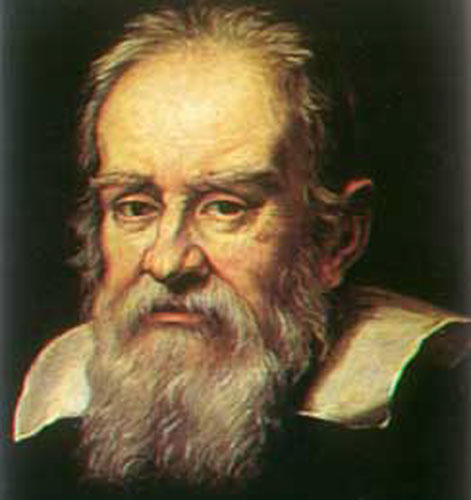History Schmistory: August 19. To go where no man would dare go before…
Monday, August 19, 2024
1960 – Sputnik Program: Sputnik 5  – the Soviet Union launches a satellite with 2 dogs, 40 mice, 2 rats and a variety of plants. The first animals to be launched into orbit and return safely. Not to take anything away from the first animals ever in space, fruit flies. Seriously. They did so well we sent them back a few years ago. Poor little guys…
-We should give a shout to Laika, the original space dog, who unfortunately didn’t make it back. RIP widdle buddy!
History Schmistory: July 29. The Final Frontier…
Monday, July 29, 2024
1958: President Dwight D. Eisenhower eagerly signs a federal statute that creates the National Aeronautics and Space Administration (NASA).
Sadly, they were never able to get him back to his home planet.
History Schmistory, July 17: Starry Eyed Harvard!
Wednesday, July 17, 2024
1850 – The Harvard Observatory took the 1st photograph of a star (Vega). Vega is argued to be the next most important star in the sky after the Sun. Needless to say, it is a “bright spot” in history for astronomers!
History Schmistory, July 11: Pons Comet Pun
Thursday, July 11, 2024
1801 – French astronomer Jean-Louis Pons discovered his 1st comet. He then went on to discover 36 more. Jeez louise!
History Schmistory, June 28: The Tomato Playing Ketch-up!
Friday, June 28, 2024
1820Â –Â The tomato was proven to be non-poisonous. Thank goodness for that…our most important foods (pizza, spaghetti, burgers) would never have been the same!
History Schmistory, June 21: Sun, You’re In Trouble!
Friday, June 21, 2024
1633 – Galileo Galilei was forced by Inquisition to “abjure, curse, & detest” his Copernican heliocentric views (the view that the  planets revolve around the sun). I guess some people couldn’t handle the thought of not being in the spot light! However, Galileo can now relax & galiLAY out to enjoy the sun, which we now know, is the real star of the show!
History Schmistory: February 15. Compute this!
Wednesday, February 15, 2023
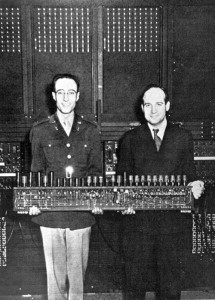 1946: ENIAC, the first electronic general-purpose computer, is formally dedicated at the University of Pennsylvania in Philadelphia. The ENIAC (electronic numerical integrator and computer) filled an entire room, weighed thirty tons, and consumed over two hundred kilowatts of power, (1 kW=1000 regular watts) so clearly the room must have felt like a sauna. Parts included over 19,000 vacuum tubes -the principal elements of the circuitry- and hundreds of thousands of resistors, capacitors, and inductors, all jumbled up inside forty-two panels nine feet tall, two feet wide, and one foot thick. And not a mouse to be found!
1946: ENIAC, the first electronic general-purpose computer, is formally dedicated at the University of Pennsylvania in Philadelphia. The ENIAC (electronic numerical integrator and computer) filled an entire room, weighed thirty tons, and consumed over two hundred kilowatts of power, (1 kW=1000 regular watts) so clearly the room must have felt like a sauna. Parts included over 19,000 vacuum tubes -the principal elements of the circuitry- and hundreds of thousands of resistors, capacitors, and inductors, all jumbled up inside forty-two panels nine feet tall, two feet wide, and one foot thick. And not a mouse to be found!
It would be decades before the true potential of the computer would be realized…

History Schmistory: February 13. “I give up.”
Monday, February 13, 2023
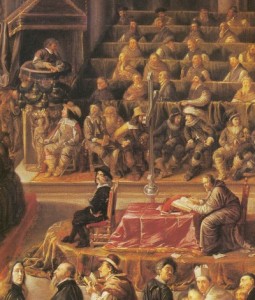 1633: After a grueling twenty-three day trip, Italian astronomer Galileo Galilei, seventy years old and suffering from excruciating sciatica, arrives in Rome for his trial before the Inquisition. Having failed to convince the cardinals with his evidence, Galileo was to be tried for heresy for professing and detailing his belief that Earth revolves around the Sun. In order to avoid a particularly torturous jail sentence, the mark of any bona fide Inquisition, Galileo had no choice but to submit, renouncing his beliefs and denying a lifetime of work so he could go back home and live out his remaining days in peace.
1633: After a grueling twenty-three day trip, Italian astronomer Galileo Galilei, seventy years old and suffering from excruciating sciatica, arrives in Rome for his trial before the Inquisition. Having failed to convince the cardinals with his evidence, Galileo was to be tried for heresy for professing and detailing his belief that Earth revolves around the Sun. In order to avoid a particularly torturous jail sentence, the mark of any bona fide Inquisition, Galileo had no choice but to submit, renouncing his beliefs and denying a lifetime of work so he could go back home and live out his remaining days in peace.
OK, Edison, it is your birthday and all.
Saturday, February 11, 2023
We must admit, we are guilty of giving Thomas Edison a lot of grief for being a back-stabbing, elephant-killing, meanie-head, but he certainly was a powerfully advantageous business man and a worthy icon for American progress and ingenuity. So, I guess we can at least say Happy Birthday to the dead guy. Here’s a great video from Jeremiah Warren that breaks down his legacy quite efficiently 🙂
Now That’s Progress! Harnessing the power of lighting.
Friday, February 10, 2023
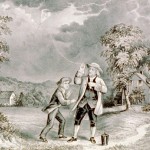 Okay, so we’ve all heard the Ben Franklin-kite flying-electricity story enough times, but what some of us may not realize is that those experiments led to one of the most important inventions in history. One that has arguably saved more lives than any other: The Lightning Rod. Pachow, pachow!
Okay, so we’ve all heard the Ben Franklin-kite flying-electricity story enough times, but what some of us may not realize is that those experiments led to one of the most important inventions in history. One that has arguably saved more lives than any other: The Lightning Rod. Pachow, pachow!
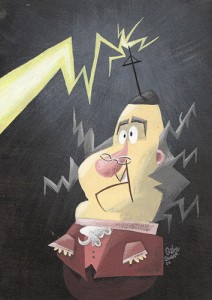 You see, most building materials like wood and drywall and… roof, are horrible conductors of electricity, so when hit with a streaking supercharge of juice, they tend to burst into flames. This can cause quite a predicament for those contained within. Back in Franklin’s day most homes and buildings were constructed with wood based materials, so it was common for lightning to ruin a perfectly good evening for many an unlucky household. The Lightning Rod offered a simple and effective solution. A pointed metal rod placed at the highest point of a structure would attract and conduct the energy a lightning bolt produces and pass it by wire down the side of a structure and into the ground where a much larger rod absorbs the bulk of the load. Genius.
You see, most building materials like wood and drywall and… roof, are horrible conductors of electricity, so when hit with a streaking supercharge of juice, they tend to burst into flames. This can cause quite a predicament for those contained within. Back in Franklin’s day most homes and buildings were constructed with wood based materials, so it was common for lightning to ruin a perfectly good evening for many an unlucky household. The Lightning Rod offered a simple and effective solution. A pointed metal rod placed at the highest point of a structure would attract and conduct the energy a lightning bolt produces and pass it by wire down the side of a structure and into the ground where a much larger rod absorbs the bulk of the load. Genius.
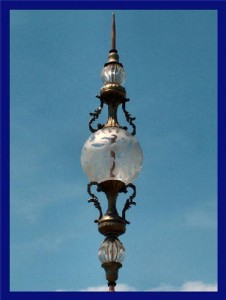
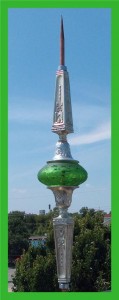 Back in the day, lightning rods were very decorative and most contained glass bulbs, which, when shattered, offered clear evidence of their awesomeness.
Back in the day, lightning rods were very decorative and most contained glass bulbs, which, when shattered, offered clear evidence of their awesomeness.
So next time you find yourself in a tall building, a dwelling on a hill, an airplane, or a yacht or something, during a crazy lighting storm, give a quick thanks to Mr. F for keeping you perfectly safe.

![By Jack Dykinga, U.S. Department of Agriculture [Public domain], via Wikimedia Commons](http://www.teammarcopolo.com/blog/wp-content/uploads/2014/08/800px-Female_Mexican_fruit_fly_insect.jpg)
![Laika Monument By Laika ac from USA (Laika) [CC BY-SA 2.0 (http://creativecommons.org/licenses/by-sa/2.0)], via Wikimedia Commons](http://www.teammarcopolo.com/blog/wp-content/uploads/2014/08/Laika_ac_Laika_6982605741.jpg)
![To infinity and beyond! By Bill Ingalls [Public domain], via Wikimedia Commons](http://www.teammarcopolo.com/blog/wp-content/uploads/2013/07/800px-STS-135_begins_takeoff.jpg)




